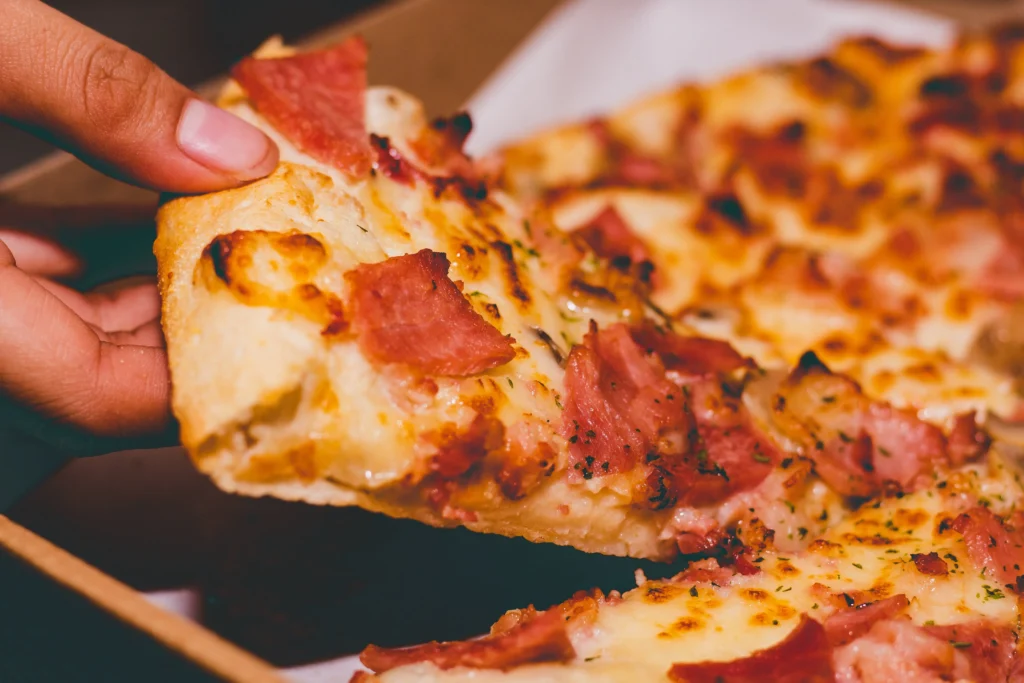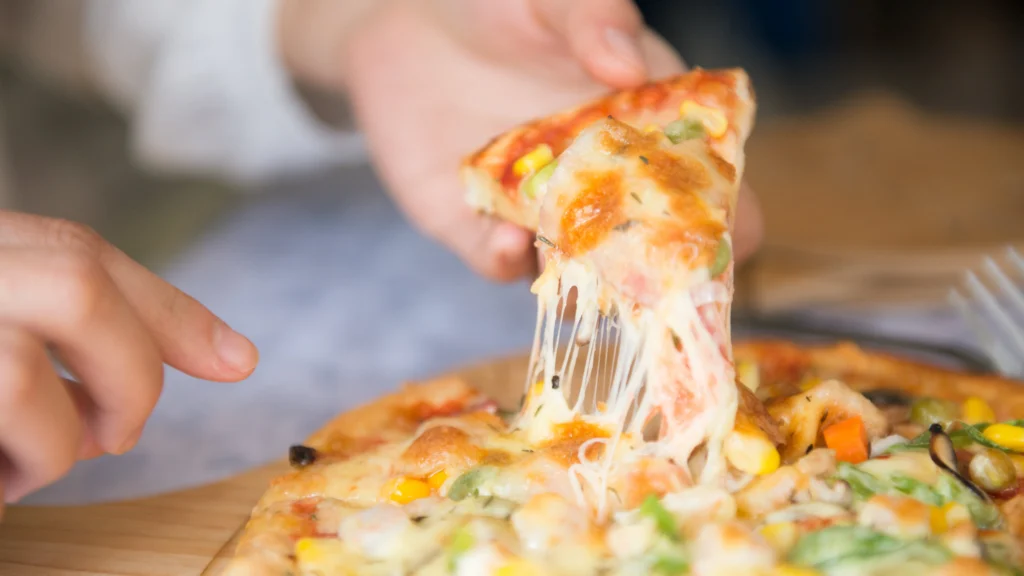Is it okay to eat pizza when you’re sick? This is a question that comes up often, and the answer may not be as straightforward as one might think. In times of illness, choosing what to eat becomes important for recovery and overall well-being. The common belief is that certain foods, especially foods high in fat and sugar like pizza, may not be the best choice during the period of illness. This belief stems from the idea that heavy, greasy foods can aggravate symptoms and hinder the body’s healing process.
However, as we delve into the intricacies of nutrition and consider the components of pizza, a nuanced perspective emerges. This blog will explore the nutritional aspects of pizza, evaluate the advantages and disadvantages of consuming it when unwell, and provide insight into whether pizza can actually be a comforting indulgence or a potential hindrance during illness. So, let’s peel away the layers of this culinary dilemma and understand the factors that come into play when deciding what to eat in inclement weather.
Nutritional Considerations
When you find yourself in inclement weather, the importance of proper nutrition cannot be underestimated. Illness often weakens the immune system and increases the need for nutrients, making it important to choose food wisely for a speedy recovery. It’s a common belief that comfort foods like pizza can provide solace during illness, but nutritional considerations should guide our choices.

Easily digestible and nutrient-rich foods play a central role in aiding recovery. While pizza, with its combination of crust, sauce, cheese and toppings, provides a mix of carbohydrates, proteins and fats, it may not always perfectly match the needs of a sick body. Choosing easily digestible options ensures that the body spends less energy on digestion, directing more resources toward healing.
In the quest for optimal nutrition during illness, a balance between rest and nutrition becomes important. We’ll find out whether pizza fits into this delicate equation, assessing its advantages and disadvantages in terms of providing the nutrients needed for faster recovery.
Components of Pizza
Crust:
Crust is a basic component of pizza, usually made from flour, water, yeast, and salt. Although it provides an adequate source of carbohydrates, it may lack essential nutrients. Choosing whole wheat or thin crust can provide more fiber and nutrients than traditional thick crust.
Sauce:
Pizza sauce is usually made from garlic, tomatoes and herbs. Tomatoes contain vitamin C and antioxidants, which may support the immune system. However, some individuals may find acidic foods irritating when they are sick. Choosing a lighter chutney or limiting the quantity may be beneficial.
Cheese:
Cheese contributes protein, calcium and fat to pizza. Although these nutrients are essential, the high fat content can take a toll on stomach upset. Choosing light cheese or reducing its quantity may make it easier to digest.
Toppings:
Toppings vary widely, providing a variety of nutritional benefits. Vegetables provide vitamins and minerals, while protein-rich toppings like chicken or lean meats contribute to muscle repair. However, heavily processed or greasy toppings may be hard to digest. Choosing a balanced mix of vegetables and low-fat proteins can enhance the nutritional profile.

Is it okay to eat pizza when you’re sick?
Pros and Cons of Eating Pizza When Sick
Benefits of eating pizza when sick:
When considering, “Is it okay to eat pizza when sick?” There are some features to consider. First, pizza often provides comforting pleasure during times of illness. Its delicious taste can bring a feeling of belonging and satisfaction. Additionally, pizza is rich in calories, which may be beneficial for people with low appetite during illness, helping to maintain energy levels. Additionally, its convenience and wide availability make it an easy choice for those who may lack the energy or inclination to prepare more elaborate meals.
Disadvantages of eating pizza when sick:
On the other hand, there are some disadvantages to eating pizza in bad weather. Pizza is heavy and greasy, which can increase feelings of nausea or indigestion that occur during illnesses. Additionally, relying on pizza as a primary food source when sick may lead to a lack of nutrients needed for a quick recovery. While pizza may provide temporary comfort, it’s important to strike a balance and consider other, more nutrient-dense options to support overall health during illness. Always listen to your body’s signals and choose foods that suit your health.
FAQs
A. Can I eat pizza when I have a cold or flu?
It’s generally okay to eat pizza when you have a cold or flu, but it’s important to eat in moderation and with caution. Pizza can provide comfort and calories, which can be beneficial when hunger is low. Opt for simple pizzas with thin crust and light toppings to avoid putting pressure on your digestive system.
B. Does pizza have any nutritional benefits for sick people?
Although pizza may not be a superfood, it does offer some nutritional benefits. The crust provides carbohydrates for energy, and toppings like vegetables and lean protein provide essential nutrients. However, it’s important to balance pizza consumption with a variety of nutrient-rich foods to support your overall health.

C. Are there specific types of pizza that are better for sick people?
Yes, choosing a pizza with thinner crust, less cheese and more vegetables can be gentler on your stomach. These options are easy to digest and provide a good balance of nutrients without the heaviness that comes with a thick crust or excessive toppings.
D. Should I avoid certain toppings when sick?
Choose lighter toppings like vegetables, chicken or turkey instead of more greasy options. Spicy or acidic toppings can aggravate symptoms like nausea or indigestion, so it is advisable to choose toppings that are easy on the digestive system.
E. Can pizza worsen symptoms like nausea or indigestion?
Pizza, especially with heavy or greasy toppings, may worsen symptoms such as nausea or indigestion in some individuals. It’s important to listen to your body and choose foods that won’t aggravate your symptoms. If you’re experiencing digestive discomfort, consider simpler and lighter options.
F. How do personal preferences and cultural factors play a role in food selection when sick?
Personal preferences and cultural factors play an important role in food selection during illness. Some may find comfort in familiar foods like pizza, while others may prefer soups or softer options. It is important to respect individual preferences and cultural influences, as these factors can impact one’s overall well-being during the illness.
Alternative Healthy Options
When considering the question, “is it okay to eat pizza when sick”, it’s important to consider alternative, healthier options that can provide comfort and nutrition without compromising your recovery. Choosing a warm and soothing bowl of chicken or vegetable soup is a wise choice. The broth helps keep you hydrated, and the vitamins and minerals from the vegetables contribute to your overall health. Additionally, herbal teas, such as ginger or peppermint, can reduce nausea and soothe a sore throat.

For those wanting a light but nutrient-dense option, a salad of leafy greens, colorful vegetables and a lean protein source can provide essential vitamins and antioxidants. Greek yogurt with honey and fruit serves as a probiotic-rich option that aids digestion and supports your immune system.
Ultimately, it is important to choose foods that are easy to digest, rich in nutrients, and hydrating. Although pizza may be tempting, exploring these healthier alternatives ensures you’re giving your body the best chance to recover efficiently.
Conclusion
Finally, the question “Is it okay to eat pizza when you’re sick?” There is nuance, and the answer depends on a variety of factors. We have explored the nutritional components of pizza, assessing its benefits and disadvantages for individuals suffering from the disease. While pizza may provide comfort and calories, its heavy and greasy nature may not be suitable for everyone, especially when dealing with symptoms like nausea or indigestion.
It is important to prioritize nutritional needs during illness, choosing foods that are easily digestible and rich in nutrients. Listening to your body becomes paramount; If pizza satisfies your cravings and doesn’t aggravate your symptoms, it may be a reasonable alternative. However, it is advisable to be mindful of alternative, healthier options.
Ultimately, the bottom line is that personal preferences, cultural factors, and specific health conditions play an important role in determining whether pizza is a suitable option during illness. Trusting your intuition and choosing foods that truly make you feel better should guide your decisions. Remember, what works for one person may not work for another, so tailor your choice based on your specific circumstances.
I invite you to share your thoughts and experiences in the comments below. Do you find pizza a comfort food while sick, or do you prefer other nutritious options? Your insight may provide valuable perspective to others struggling with this delicious dilemma. Remember, there is no single right answer – let’s create space for open dialogue and shared knowledge.




